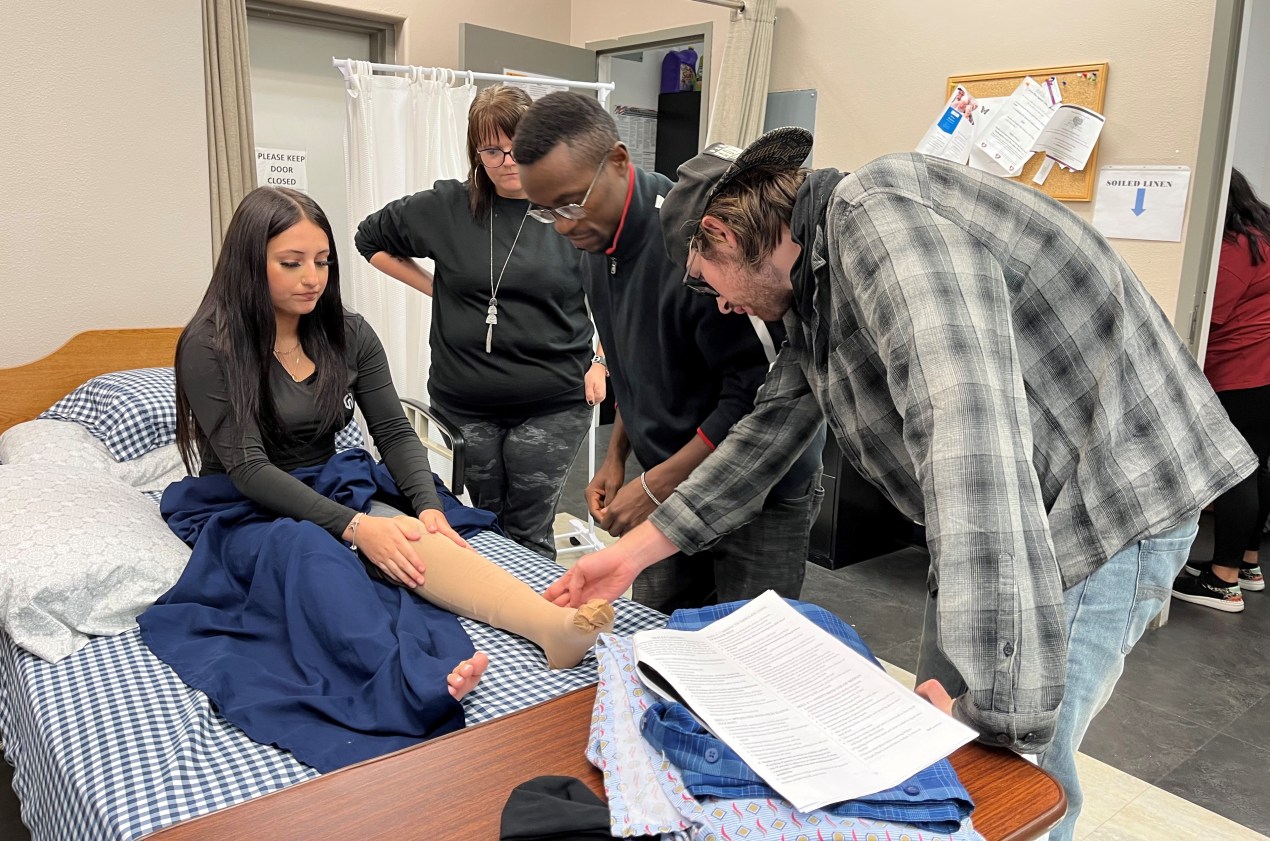GRAND JUNCTION, Colo. — During her 12-hour overnight shift, Brianna Shelton helps residents at BeeHive Homes Assisted Living go to the bathroom. Many of them have dementia, and some can’t get out of bed on their own. Only a few can remember her name, but that doesn’t matter to her.
“They’re somebody’s mom, somebody’s grandma, somebody’s great-grandmother,” Shelton said. “I want to take care of them like I would take care of my family.”
Shelton trained to be a personal care aide through an apprenticeship program designed to meet the increasing need for health care workers in rural western Colorado. Here, far from Denver’s bustling urban corridor, worker shortages mount as baby boomers retire, young people move away from these older communities, and demand for health care in homes and facilities rises.
Rural areas often have larger shares of residents who are 65 or older than urban areas do. And the most rural regions have relatively fewer direct care workers, like personal care aides, to help people with disabilities than less-rural regions do, according to a recent study in the journal Health Affairs.
Besides increasing the number of direct care workers, the Colorado apprenticeship program offers opportunities for improving earning power to residents who live at or below the poverty line, who lost their jobs during the covid-19 pandemic, or who are unemployed or underemployed. They train to become personal care aides, who help patients with daily tasks such as bathing or housekeeping, or certified nursing assistants, who can provide some direct health care, like checking blood pressure.
Apprentices take training classes at Western Colorado Area Health Education Center in Grand Junction, and the center pays for students who live in more rural areas to attend classes at Technical College of the Rockies in Delta County. The apprentices receive on-the-job training with one of 58 local employers — an assisted living facility, for example — and they are required to work there for one year. Each apprentice has an employer mentor. Staff members at Western Colorado AHEC also provide mentorship, plus the center has a life coach on hand.
“We really just want students to get into health care, get jobs, and retain those jobs,” said Georgia Hoaglund, executive director of Western Colorado AHEC, which has 210 active apprentices and was bolstered by a $2 million grant from the U.S. Labor Department in 2021.
Some apprentices are recent high school graduates. Others are single mothers or veterans. They often have educational or economic barriers to employment. Hoaglund and her staff of 10 buy the apprentices scrubs so they can start new jobs with the right uniforms; otherwise, they might not be able to afford them. Staff members pay for apprentices’ gas if they can’t afford to fill up their tanks to drive to work. They talk to apprentices on the phone monthly, sometimes weekly.
Even though the apprenticeship program gives these workers a solid start, the jobs can be stressful, and burnout and low pay are the norm. Career advancement is another obstacle, said Hoaglund, because of the logistics or cost of higher education. Hoaglund, who calls her staff family and some of the apprentices her kids, dreams of offering more advanced training — in nursing, for example — with scholarship money.
Apprenticeships are perhaps better known as a workforce training tool among electricians, plumbers, carpenters, and other tradespeople. But they are also viewed as a way of building a needed pipeline of direct care health workers, said Robyn Stone, senior vice president for research at LeadingAge, an association of nonprofit providers of aging services.
“Traditionally, health care employers have hired people after they finish a training program,” said Susan Chapman, a registered nurse and a professor in the school of nursing at the University of California-San Francisco. “Now, we’re asking the employer to take part in that training and pay the person while they’re training.”
The pandemic exacerbated shortages of direct care workers, which could encourage employers to invest in apprenticeships programs, both Chapman and Stone said. Federal investment could help, too, and a Biden administration initiative to improve the quality of nursing homes includes $35 million in grants to address workforce shortages in rural areas.

Shelton had never worked in health care before moving to Fruita, a small town that is about 12 miles northwest of Grand Junction and is surrounded by red sandstone towers. She left Fresno, California, a year ago to take care of an uncle who has multiple sclerosis. She and her 16-year-old daughter live in a trailer home on her uncle’s property, where Blackie, her rescue Labrador retriever, roams with the chickens and cats.
Blackie also sometimes accompanies Shelton to BeeHive to visit with the residents. Shelton said that it is more than a job to her and that she is grateful to the apprenticeship program for helping her get there. “It opened a door for me,” Shelton said.
Shelton works three 12-hour shifts a week, in addition to taking care of her uncle and daughter. Yet, she said, she struggles to have enough money for gas, bills, and food and has taken out small loans to make ends meet.
She is not alone. Personal care aides are often underpaid and undervalued, said Chapman, who has found significantly higher poverty rates among these workers than among the general population.
Direct care workers nationwide, on average, make $13.56 an hour, according to a study by nonprofit policy group PHI, and these low wages make recruiting and retaining workers difficult, leading to further shortages and instability.
In an effort to keep workers in the state, Colorado raised the minimum wage for personal care aides and certified nursing assistants to $15 an hour this year with money from the American Rescue Plan Act. And the Colorado Department of Health Care Policy and Financing’s 2023-24 budget request includes a bump to $15.75. Similar efforts to raise wages are underway in 18 other states, including New York, Florida, and Texas, according to a recent paper from the National Governors Association.
Another way to keep apprentices in jobs, and encourage career and salary growth, is to provide opportunities for specialized training in dementia care, medication management, or behavioral health. “What apprenticeships offer are career mobility and advancement,” Stone said.
To practice in Colorado, new certified nursing assistants complete in-class training, do clinical rotations, and pass a certification exam made up of a written test and a skills test. Hoaglund said the testing requirements can be stressful for students. Shelton, 43, has passed the written exam but must retake the skills test to become licensed as a certified nursing assistant.
Hoaglund’s program started in 2019, but it really took off with the 2021 federal grant. Since then, 16 people have completed the program and have received pay increases or promotions. Twice as many people have left without finishing. The largest hospital in Grand Junction, Intermountain Healthcare-St. Mary’s Medical Center, recruits workers from the program.
Hoaglund said each person who enters the health care field is a win.
Brandon Henry, 23, was a student at Colorado Mesa University in Grand Junction and working at PetSmart before he joined the apprenticeship program in 2019. After enrolling, he trained and worked as a certified nursing assistant through the worst of the pandemic. As an apprentice, he said, he learned the importance of having grace while caring for patients.
He went back for more training at Western Colorado AHEC to earn a license that allows him to dispense medicine in accredited facilities, such as assisted living centers. He now works at Intermountain Healthcare-St. Mary’s Medical Center, where he took training classes in wound care and physical therapy hosted at the hospital. This winter, he’ll graduate from Colorado Mesa with a Bachelor of Science in nursing.
“At the hospital, I’ve found more opportunities for pay raises and job growth,” Henry said.







